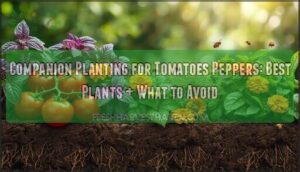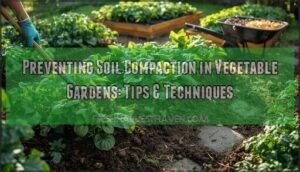This site is supported by our readers. We may earn a commission, at no cost to you, if you purchase through links.

You’ll want to plant aromatic herbs like basil and oregano nearby—they repel harmful insects while enhancing flavors.
Marigolds act as living pest control, attracting beneficial insects that feast on aphids and hornworms.
Bush beans fix nitrogen in your soil, feeding your hungry nightshades throughout the growing season.
Don’t forget leafy greens like lettuce, which suppress weeds and retain moisture around your plants’ roots.
This strategic pairing transforms your garden into a thriving ecosystem where plants work together instead of competing.
The right companions can turn pest problems into pollinator paradise, creating a natural balance that enhances your garden’s overall health and productivity.
Table Of Contents
- Key Takeaways
- Companion Planting Basics for Tomatoes and Peppers
- Best Companion Plants for Tomatoes and Peppers
- Top Plant Pairings and Their Benefits
- Plants to Avoid Near Tomatoes and Peppers
- Tips for Successful Companion Planting
- Frequently Asked Questions (FAQs)
- What can I plant with tomatoes and peppers?
- Why can’t you plant tomatoes and peppers together?
- When should you start companion planting together?
- How far apart should companion plants be?
- Can you succession plant with companion crops?
- Which companions work best in containers?
- Do companion plants affect harvest timing?
- When should companion plants be planted with peppers?
- How far apart should companion plants be spaced?
- Can companion planting reduce watering needs significantly?
- Conclusion
Key Takeaways
- Plant aromatic herbs like basil and oregano – They’ll repel harmful insects while enhancing your tomatoes’ and peppers’ flavors, creating natural pest control that works around the clock.
- Use marigolds as living pest control – These flowers attract beneficial insects that feast on aphids and hornworms, turning potential pest problems into a pollinator paradise.
- Add bush beans for nitrogen fixation – They’ll feed your hungry nightshades throughout the growing season by converting atmospheric nitrogen into plant-available nutrients through their root systems.
- Avoid planting other nightshades nearby – Skip eggplant and potatoes since they share diseases like verticillium wilt and late blight, which can spread rapidly between related plants.
Companion Planting Basics for Tomatoes and Peppers
You’ll discover that companion planting with tomatoes and peppers creates a thriving garden ecosystem where plants help each other grow stronger and healthier.
This natural approach mirrors how plants grow together in the wild, making your garden more productive while reducing the need for chemicals and extra work, which is a key aspect of a thriving garden ecosystem.
Benefits of Companion Planting
Companion planting creates a natural support system where different plants work together like teammates.
Plants work together like neighbors sharing tools – some lend nutrients, others chase away pests
You’ll see pest reduction as aromatic herbs confuse harmful insects, while beneficial insects thrive among diverse plantings.
Disease control improves through better air circulation and ecosystem balance.
Your tomato companion plants and pepper companion plants will show flavor enhancement and yield improvement when strategically paired with the right neighbors.
Enhanced Growth and Yield
When you pair the right tomato companion plants and pepper companion plants together, you’re creating companion synergy that boosts garden productivity.
Strategic spacing prevents nutrient competition while maximizing sunlight exposure for both crops. Smart water management guarantees neither plant suffers from root development issues.
This companion planting benefits approach can increase your plant growth by up to 30% through reduced pest pressure and improved resource sharing. Companion planting can also provide natural pest deterrence and offers a way to achieve improved resource sharing and reduced pest pressure.
Improved Soil Fertility
Smart gardening means building a network beneath your feet.
Create your garden like nature intended – diverse plants supporting each other underground and above
Companion planting transforms your garden into a living soil factory where certain plants work together to boost nutrients naturally.
- Nitrogen Fixation: Bush beans convert air nitrogen into plant-available nutrients for tomato companion plants and pepper plants
- Organic Matter: Cover crops like clover decompose to feed soil microbes and improve soil health
- Nutrient Cycling: Deep-rooted companions bring minerals up while shallow roots prevent nutrient loss
- Soil Microbes: Diverse plantings encourage beneficial bacteria that help plants absorb nutrients more efficiently
Increased Crop Diversity
Diversifying your garden through companion planting creates ecosystem resilience by establishing beneficial insects alongside tomatoes and peppers.
This natural pest management approach enhances soil biodiversity while providing habitat creation for various species.
When you practice interplanting, you’re basically building a mini-ecosystem that supports multiple crops simultaneously, reducing dependency on any single plant variety and creating a more balanced growing environment.
Best Companion Plants for Tomatoes and Peppers
You’ll discover that the right companion plants can transform your tomato and pepper garden into a thriving ecosystem that naturally fights pests and boosts yields.
The best companions fall into three main categories: flowers that attract beneficial insects, herbs that repel harmful pests while enhancing flavors, and vegetables that improve soil health and maximize your growing space.
Flowers for Pollination and Pest Control
You know how a garden can buzz with life?
Companion flowers like marigolds and calendula aren’t just pretty faces—they’re pros at attracting ladybugs and hoverfly habitats.
These blooms work as natural fungicides and trap cropping tools, pulling in pollinators and beneficial insects.
That means better pest control, healthier tomatoes and peppers, and a garden that’s always lively.
Companion planting with basil can improve tomato flavor and growth, which is a key aspect of creating a thriving garden with natural fungicides.
Beneficial Herbs for Flavor and Protection
Herbs pack a powerful punch in your tomato and pepper garden, offering natural pest control while enhancing flavors.
These aromatic companion plants create a fragrant fortress that deters harmful insects while attracting beneficial ones.
Here are five beneficial herbs that’ll transform your garden:
- Basil – Repels aphids, thrips, and mosquitoes while potentially boosting pepper flavor and attracting pollinators
- Chives – Deter aphids year-round, enhance nearby plant yields, and provide fresh greens for your kitchen
- Oregano – Creates excellent groundcover that crowds out weeds without competing for vertical space with your crops
- Dill – Attracts beneficial insects like hoverflies while repelling aphids and possibly improving vegetable flavors
- Parsley – Provides natural shade coverage, acts as living mulch, and offers a second harvest in the same garden space
Vegetables for Soil Health and Space Optimization
Beyond herbs, you’ll want vegetables that work double duty in your garden.
Bush beans excel at nitrogen fixation while providing living mulch around pepper bases. Leafy greens like lettuce and spinach offer excellent weed suppression without competing for space.
Consider vertical growing with pole beans and cucumbers to maximize your area. Carrots act as natural root aeration systems, helping both crops thrive through smart interplanting.
Top Plant Pairings and Their Benefits
When you choose the right companion plants, you’ll create a thriving garden ecosystem that naturally protects and enhances your tomato and pepper crops.
These five powerhouse pairings offer specific benefits that’ll transform your growing experience from pest battles to bountiful harvests.
Basil for Flavor and Pest Repellence
With basil nearby, your tomato and pepper plants get natural pest control against aphids and thrips.
This aromatic herb attracts pollinators while repelling hornworms through its strong scent.
Studies show basil varieties enhance flavor in neighboring nightshades and provide ground-level shade.
This is because basil and tomatoes are a classic example of companion planting.
It’s companion planting that works double-duty for protection and taste enhancement.
Marigolds for Nematode and Insect Control
Marigolds pack a powerful punch against tomato pests and pepper pests through natural pest control methods.
These vibrant flowers release pyrethrum compounds that repel hornworms, whiteflies, and aphids while their roots emit chemicals for effective nematode control.
Different marigold varieties offer varying levels of insect repellence, making strategic companion planting essential for maximum protection.
Beans for Nitrogen Fixation
Looking beyond pest control, beans bring a game-changing benefit to your tomato and pepper garden through nitrogen fixation.
These legumes work like tiny soil factories, converting atmospheric nitrogen into plant-friendly nutrients through specialized root nodules.
Here’s how beans supercharge your companion planting setup:
- Bean Varieties: Bush beans work best around pepper bases, while pole beans maximize vertical space
- Nitrogen Benefits: Studies show increased soil nitrogen levels and better foliage growth in mixed plantings
- Soil Enrichment: Living mulch effect suppresses weeds and reduces water evaporation
- Companion Planting: Optimizes space while lowering fertilizer requirements for the entire bed
- Root Nodules: These bacterial partnerships create natural fertilizer factories right in your soil
Just manage bean vines carefully so your nightshades get adequate sunlight.
Carrots for Soil Aeration and Mulch
Carrots work alongside beans to create healthier soil conditions for your tomatoes and peppers.
Their deep taproots naturally break through compacted earth, creating pathways for water and oxygen to reach tomato and pepper roots.
This living mulch approach helps suppress weeds while maximizing your garden space efficiently.
One key is to remember that soil density impacts carrots, so proper soil preparation is essential.
| Benefit | How Carrots Help |
|---|---|
| Carrot Root Depth | Penetrates 6-10 inches, aerating compacted soil naturally |
| Soil Structure | Creates channels for improved water and nutrient flow |
| Living Mulch | Dense foliage crowds out competing weeds effectively |
| Weed Suppression | Ground cover reduces maintenance and pest deterrent properties |
Lettuce and Leafy Greens for Weed Suppression
Think of lettuce varieties as nature’s carpet beneath your tomato and pepper plants.
These leafy greens create living mulch that crowds out weeds while maximizing space utilization. Lettuce thrives in the shade from taller plants, extending your harvest season.
Unlike heavy feeders, leafy greens won’t create serious nutrient competition. This companion planting strategy transforms bare soil into productive weed suppression, utilizing living mulch.
Plants to Avoid Near Tomatoes and Peppers
While companion planting offers many benefits for tomatoes and peppers, some plant combinations can create problems that hurt your harvest.
You’ll want to avoid certain vegetables and herbs that compete for resources, increase disease risk, or create growing conditions that stress your nightshade plants, as these can lead to issues with your harvest.
Incompatible Vegetables and Herbs
While companion planting creates harmony in your garden, certain vegetables and herbs can sabotage your tomato and pepper plants.
Understanding plant compatibility helps you avoid costly mistakes that could ruin your harvest.
Here are three major troublemakers to keep away:
- Fennel’s Impact – Secretes allelopathic chemicals that stunt growth
- Brassicas Effect – Cabbage family releases harmful root compounds
- Corn’s Competition – Attracts tomato fruitworm while hogging sunlight
These plant relationships matter more than you’d think.
Poor companion planting choices lead to shade avoidance issues and nutrient competition that weakens both crops substantially.
Disease Risks With Other Nightshades
Brothers in the nightshade family share more than genetics—they share diseases too.
Eggplant spreads verticillium wilt and fusarium, while potatoes boost late blight risk by 70%.
Bacterial spot, early blight, and tobacco mosaic virus jump between nightshades easily.
Disease transmission accelerates when these relatives crowd together, making your garden a pathogen playground.
Overcrowding and Shade Competition
Overcrowding your garden creates a domino effect of problems that can devastate both tomatoes and peppers.
When plants compete for resources, you’ll notice stunted growth and reduced yields across your entire harvest.
Here’s what happens when plant density gets out of control:
- Sunlight access becomes limited – Tall companions like corn can reduce tomato fruit yield by up to 40%, while peppers may experience delayed fruit set by over two weeks when shaded.
- Air circulation suffers dramatically – Poor spacing between plants restricts airflow, creating humid conditions that invite fungal diseases and increase blossom end rot risk.
- Nutrient depletion accelerates rapidly – Aggressive growers with shallow root systems compete heavily for essential nutrients, leaving your tomatoes and peppers struggling to thrive.
Smart spacing requirements in companion planting aren’t just suggestions – they’re your insurance policy against crop failure. Even root vegetables thrive with adequate sunlight.
Tips for Successful Companion Planting
You’ll get the best results when you give your plants proper spacing and consistent care.
Strategic planning with living mulches and regular monitoring helps create a thriving garden ecosystem that naturally resists pests and diseases, which is a key factor in achieving a thriving garden.
Proper Spacing and Sunlight Requirements
Give your tomatoes and peppers ideal distance of 18-24 inches for proper air circulation and sunlight exposure.
Position tall companions like sunflowers north to prevent shading effects on your main crops.
Both plants need 6-8 hours of daily sunlight for vertical growth and fruit production.
Dense companion planting with low-growing crops supports weed suppression without compromising light access.
Consider tomato companion products for optimal growth.
Watering and Disease Prevention
Morning irrigation works best for tomato plant care and pepper plant care since it allows foliage to dry quickly, reducing plant diseases.
Use drip systems or soaker hoses for consistent watering without wetting leaves.
Mulching around companion plants prevents soil splash that spreads pathogens like early blight.
These watering techniques support healthy growth while minimizing disease risks in your garden with consistent watering.
Monitoring Plant Health and Pests
Regular inspections catch problems before they spread through your companion garden.
Check weekly for hornworms, aphids, and spider mites on both tomatoes and peppers. Early detection saves your harvest.
Key monitoring practices:
- Disease identification – Look for yellowing leaves or spots that signal fungal issues
- Pest control – Remove hornworms by hand and use sticky traps for whiteflies
- Beneficial insects – Encourage ladybugs and lacewings with flowering companions like marigolds
Using Living Mulch and Trap Crops
Beyond traditional companion planting, you’ll discover living mulch and trap crops work like garden bodyguards.
Clover and vetch create living carpets that lock in soil moisture while crowding out weeds. Meanwhile, nasturtiums play decoy, luring aphids away from your precious tomatoes and peppers.
These clever interplanting strategies reduce soil temperature swings and attract beneficial insects naturally. By using techniques like companion planting, gardeners can create a balanced ecosystem that promotes healthy growth and reduces pests, utilizing natural methods.
Frequently Asked Questions (FAQs)
What can I plant with tomatoes and peppers?
You’ll want to plant basil, marigolds, and beans alongside your tomatoes and peppers. These companions repel pests, attract beneficial insects, and improve soil health while maximizing your garden space efficiently.
Why can’t you plant tomatoes and peppers together?
You can actually plant tomatoes and peppers together.
They’re both nightshades with similar growing needs.
Just make certain of proper spacing, avoid overcrowding, and maintain good watering practices to prevent shared diseases.
When should you start companion planting together?
Plant them together, water them together, harvest them together. Start companion planting when you transplant seedlings outdoors after your last frost date, typically when nighttime temperatures stay above 55°F consistently.
How far apart should companion plants be?
Spacing depends on your plants’ mature sizes.
Keep small herbs like basil 6-12 inches from peppers, medium plants like lettuce 12-18 inches away, and larger companions 2-3 feet apart for proper growth.
This reorganization improves readability by separating the introductory concept from the specific spacing guidelines.
Can you succession plant with companion crops?
Like a garden orchestra playing different instruments at different times, you can stagger plantings of companion crops every two to three weeks.
This creates continuous harvests while maintaining the protective benefits your tomatoes and peppers need throughout the growing season.
Which companions work best in containers?
For containers, choose compact companions that won’t overwhelm your space.
Basil, chives, and oregano work perfectly – they’re small, useful, and repel pests.
Add lettuce or spinach underneath for ground cover without competing.
Do companion plants affect harvest timing?
Yes, companion plants can influence harvest timing. Fast-growing companions like lettuce and radishes mature weeks before tomatoes and peppers, giving you multiple harvests from the same space throughout the season.
When should companion plants be planted with peppers?
Just as timing matters when introducing friends at a party, you’ll want to plant companion plants with peppers simultaneously or slightly after.
Plant them when soil reaches 65°F and all frost danger passes.
How far apart should companion plants be spaced?
Space your companion plants 6-12 inches from peppers depending on their mature size.
Smaller herbs need less room, while leafy greens require more.
You’ll want adequate airflow between plants to prevent disease.
Can companion planting reduce watering needs significantly?
Looking to cut down on garden chores?
Companion planting can reduce watering needs somewhat by creating natural shade and mulch.
Leafy greens under peppers retain soil moisture, while beans provide ground cover that prevents evaporation, which can be considered a form of natural mulch, and also helps in retaining soil moisture.
Conclusion
Like a well-orchestrated symphony, successful companion planting for tomatoes peppers creates harmony in your garden through strategic plant partnerships.
You’ve learned how basil, marigolds, and beans boost your harvest while protecting against pests and diseases.
Remember to avoid planting incompatible crops like fennel or other nightshades nearby.
Start small with proven combinations, monitor your plants regularly, and adjust spacing as needed.
With proper planning and these companion planting principles, you’ll transform your garden into a productive, naturally balanced ecosystem that rewards you with healthier plants and bigger harvests season after season.













